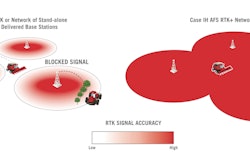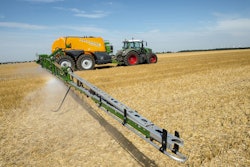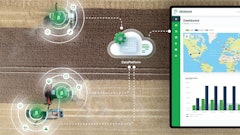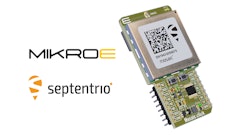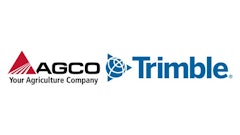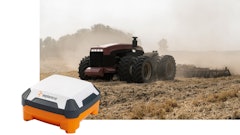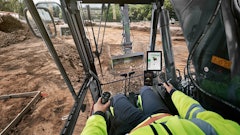AgJunction Inc. has reported financial results for the fourth quarter and year ended December 31, 2015. All currency amounts are expressed in U.S. dollars.
AgJunction also announces the adoption of an advance notice bylaw (the Bylaw) and approval by the board of directors of AgJunction of an amended and restated shareholder rights plan agreement.
Post-Merger Update
AgJunction's mission is to become one of the world's leading original equipment manufacturer (OEM) and value added reseller (VAR) supplier for automated steering and machine control technology for precision agriculture.
During the fourth quarter of 2015, AgJunction successfully completed a merger with Novariant Inc., strengthening its position within the OEM precision guidance and machine control markets. The combined organization is differentiated by its ability to deliver application-specific technology to precision agriculture customers worldwide. The merger resulted in internal changes including leadership changes at the board and management levels, and structural changes allowing for the merger of both companies.
Leadership Team
In addition to the appointment of Dave Vaughn as the President and Chief Executive Officer, the company has attracted and retained a strong leadership team focused on innovation and intellectual property, with a deep understanding of regional requirements for new product introduction.
Bob Barjesteh has been appointed VP Intellectual Property (IP) and General Counsel. Barjesteh is managing the company's substantial patent portfolio and leading AgJunction's IP team. AgJunction's IP portfolio is a strategic asset and an area of focus and continued investment.
In addition, Kevin Monk joined the company as Vice President of Global Marketing to lead marketing initiatives and develop go-to-market strategies for the combined company. Monk is leading the integration of the product road map to position AgJunction as the industry's supplier of choice.
Further, AgJunction announces the appointment of Mike Manning as Senior Vice President and Chief Financial Officer of the Company effective April 1, 2016. Manning has been the Interim Senior Vice President and Chief Financial Officer of the company since July 7, 2015.
Global Presence
Combined, the company has a larger global presence with 160 employees worldwide. The company maintains Executive Offices in Fremont, CA, and Corporate Headquarters and Finance Offices in Hiawatha, KS. A global presence is maintained with research and development (R&D) facilities in Scottsdale, AZ, Brisbane, Australia, Fremont, CA, and Hiawatha, KS, with worldwide sales and support presence in the USA, Canada, Europe, South America, and China. AgJunction maps to its customers' locations and scales to the customer base, surrounding them with critical sales, product and engineering teams. Customer pursuit, retention and care are paramount to AgJunction's go-to-market strategy.
Patents and Intellectual Property (IP)
AgJunction believes that its diverse intellectual property portfolio is among the broadest and most diverse in the precision steering and machine control market. Foundational and key patents are built around the core elements of guidance, auto-steering, mapping, task control, GNSS and machine control, with many patents valid past 2025. A key strength of patent IP is that it provides attractive security and protection for partners who integrate AgJunction solutions.
Products
AgJunction designs, manufactures and markets innovative and cost-effective technology products for ground and air-based agriculture applications. The precision solutions offered by AgJunction help end users gain efficiency and decrease costs resulting in higher returns to the customers' bottom line.
With the completion of the merger, the company offers customers a broader and differentiated product suite. Existing products will maintain their respective branding. AgJunction's engineering teams are working on complementary technologies around automated steering and machine control solutions including sensor fusion and control with an interoperable solutions architecture.
OEM, VAR, and Aftermarket Retail Sales
Reliable auto-steering is a prerequisite to precision agriculture successfully increasing productivity in the field. A strategic market shift is underway as machine manufacturers worldwide increasingly integrate auto-steer technologies at the factory level. Globally, AgJunction partners with leading OEMs in each region to integrate its solutions into their machines. VAR customers integrate AgJunction technology into their solutions to provide a complete system for after-market customers. AgJunction also provides a leading solution directly to the end user through its Outback and Satloc product lines.
State of the Agriculture market
In February 2016, the United States Department of Agriculture (USDA) reported1 both net cash and net farm income are forecast to decline for the third consecutive year. Net farm income is forecast to be $54.7 billion in 2016, down 2.5% from the 2015 forecast level. The 2016 forecast for net farm income would be the lowest since 2006 and a drop 56% from the record high of $123.3 billion in 2013.
AgJunction management views the fundamentals of its global agriculture markets to be neutral to slightly down in 2016 versus 2015. However, management believes that globally, there are currently pockets of opportunity. In the long term, management believes that worldwide market demand driven by population growth, limited arable land, and a relatively low global penetration of precision agriculture technologies will lead to favorable conditions for the company's products.
The company continues to experience increased activity in China as the Chinese government increased its support for the sector. In recent press conference comments, China's Agriculture Minister Han Changfu discussed China's need to focus on supply side reform, especially in corn, because of bumper harvests and surplus grain stockpiles. Han indicated that increasing farmer incomes will be a government priority over the next 5 years, with a focus on agricultural industrialization, cutting costs and improving technology. AgJunction is providing core technology to Chinese partners resulting in Chinese-manufactured solutions which qualify for the government assistance programs.
"The industry forecast for 2016 remains challenging for companies in the agriculture space," says Dave Vaughn, AgJunction's CEO. "Due to this and to duplication of resources identified after the merger, at the end of 2015 we embarked on a proactive reduction in workforce to decrease our operating costs for 2016. Coinciding with our internal focus on operating costs and efficiencies, our external focus in 2016 is to leverage the synergies created by the merger, reducing costs and increasing customer satisfaction to return to profitable growth. The precision agriculture industry continues to evolve at an increased rate and as a combined company, we believe we are uniquely positioned to support this high pace of innovation and technology integration with current and anticipated new product offerings for both end-users and farm equipment manufacturers."
Fourth Quarter Financial Review
AgJunction's consolidated 2015 fourth quarter results are presented as a combined entity. However, because the merger was completed after the start of AgJunction's fourth quarter, the financial results in this fourth quarter financial report include only 77 days of Novariant's operations versus the full 92 days of AgJunction's operations. The comparative fourth quarter ended December 31, 2014 does not include Novariant's operations.
For the three months ended December 31, 2015, the company reported revenue of $11.6 million, a 17% increase from $10.0 million in the fourth quarter of 2014. Of the $11.6 million, $8.4 million- or 72%- was contributed by AgJunction and $3.2 million- or 28%- was contributed by Novariant. Year-over-year fourth quarter revenues for AgJunction (excluding Novariant) declined 15% as the company's combined end-markets continued to experience general softness globally.
Total revenue in the Americas region for the quarter was up 14% from 2014 as a result of the acquisition of Novariant. In other regions, sales increased 52% in Asia Pacific (APAC) to $0.9 million and 15% in Europe, Middle East and Africa (EMEA) to $5.4 million. The OEM and VAR business is a core focus of the recently merged entity and new partners were signed during the fourth quarter.
Special Operating Result Analysis and Expense Detail of Q4 2015
Due to the timing of the completion of the merger with Novariant in the fourth quarter of 2015 and the integration of the two companies, management has included additional information that will not be provided in future reporting of financial results.
Certain items impacting net income (loss) in Q4 were related to the acquisition of Novariant or related restructuring, which had a one-time impact on results. The unusual decrease in gross margin was largely attributable to over $0.6 million of higher cost of goods sold relating to Q4 sales of Novariant inventory whereby that inventory had been written up to fair value at acquisition as part of standard purchase accounting processes. Also contributing to the gross margin decrease in Q4 was $0.3 million of inventory write-downs related to overlapping product lines between the merged companies. There is an additional $0.3 million fair value write up of Novariant inventory from purchase accounting processes on the balance sheet as of December 31, 2015 which will impact Q1 2016 results. Total impact to gross margin in the fourth quarter of 2015 related to the merger, restructuring and other items denoted below was $1.1 million. Excluding these non-recurring items, gross profit in the fourth quarter of 2015 would have been approximately $3.9 million or 34% of sales.
In addition to the non-recurring items detailed above, gross margin was impacted by an additional $0.5 million of obsolescence reserve, $0.3 million of warranty costs, and approximately $0.5 million in lower margins related to low sales volume in Q4. These items had an impact of $1.3 million or an additional 10 percentage points on gross margin after adjusting for the above non-recurring expenses.
Standard Operating Expense Analysis of Q4 2015
Total operating expenses were $7.8 million in the fourth quarter up $3.1 million or 65% from $4.7 million in the fourth quarter of 2014 with $1.3 million of the increase a result of ongoing operating expenses picked up from the fourth quarter merger with Novariant, but also including non-recurring charges totaling approximately $1.5 million, detailed above. In the course of post-merger integration activities, duplicate resources were identified. Accordingly, on December 30, 2015 the company announced a reduction targeted at 20% of its work force. This restructuring is expected to reduce annual operating costs by approximately $3.3 million going forward with a related one-time restructuring charge of $0.5 million incurred in December 2015.
General and administrative expenses were $3.2 million and included non-recurring $0.6 million in increased compensation costs of key management personnel, $0.4 million in Novariant merger transaction related costs, and $0.4 million in restructuring costs. Research and development expense of $2.9 million was 81% or $1.3 million higher in the fourth quarter of 2015 of which approximately $0.8 million was attributable to Novariant departmental expenses, $0.4 million was related to lower capitalization of research and development costs, and $0.1 million was related to restructuring costs. Sales and marketing expenses of $1.7 million were 21% higher than the fourth quarter of 2014.
AgJunction has capitalized certain development costs over the last several years, as required under International Financial Reporting Standards (IFRS) rules when specific requirements are met. IFRS accounting rules require that the completed project costs be amortized over the expected life of the intangible asset. The major projects being worked on were completed in 2015, and a thorough analysis of all intangible assets was completed in the fourth quarter. AgJunction determined the recoverability of these research and development intangibles was not probable, which resulted in an impairment of $4.7 million, the full amount that was on the books for these intangible assets.
For the fourth quarter ended December 31, 2015, the company reported a net loss of $9.9 million, or ($0.09) per share, compared to a net loss of $16.5 million, or ($0.23) per share, in the fourth quarter of 2014. The $9.9 million net loss for the quarter would have been about $2.6 million without the $4.7 million intangible impairment and the $2.6 million of acquisition related and other one-time expenses detailed above.
Twelve Month Financial Review
For the year ended December 31, 2015, total revenue was $39.0 million representing a 13% decrease from $44.8 million in 2014. Gross margin for the year was $14.8 million, or 38%, versus $20.3 million, or 45%, in 2014. The $5.5 million decrease resulted partly from decreased revenue, partly from acquisition related items, and partly from an inventory write-down and increase in the inventory allowance taken in the fourth quarter.
Total operating expenses were $20.6 million in 2015, down by 2% or $0.4 million from $21.0 million in 2014. Operating expenses were lower throughout 2015 primarily due to decreases in engineering headcount, the sale of the Agronomy Services business, decreases in project spending, and an increase in capitalized R&D.
R&D expenditures of $6.7 million declined from $7.1 million in 2014 representing a decrease of $0.4 million or 6%. Sales and marketing expenses were $5.4 million in 2015, down by 13% or $0.8 million from $6.2 million in 2014, due to reduced spending on external advertising.
General and administrative expenses for 2015 were $8.4 million compared to $7.7 million in 2014 representing an increase of $0.7 million or 9%. As reported in 2014, the company incurred litigation costs of $1.8 million relating to a lawsuit the company brought against a competitor believed to be infringing on the company's proprietary software, however the current year also had significant legal costs related to the Novariant acquisition and other legal costs surrounding legal reviews of combined company synergies. Net of transaction specific costs in 2014 and 2015, the remaining difference of $0.6 million relates to increased compensation costs of key management personnel, of which $0.6 is non-recurring.
For the year, AgJunction realized a loss from continuing operations of $9.1 million or ($0.11) per share (basic and diluted) in 2015 compared to a loss from continuing operations of $16.7 million or ($0.23) per share (basic and diluted) in 2014. In 2014, the company recognized a goodwill impairment of $15.9 million. In October 2015, the company issued 49,291,026 common shares as consideration in the acquisition of Novariant representing $24.9 million. In 2016, the company recognized an impairment charge to intangible assets of $4.7 million. As of March 28, 2016, AgJunction has 123,405,391 common shares outstanding and 6,969,823 stock options outstanding. Directors, officers and other insiders directly or indirectly hold or represent approximately 28% of the outstanding common shares.
On December 31, 2015, the company held cash of $13.0 million which included $1.6 million of the $3.6 million acquired in the merger with Novariant. This compares to cash held of $11.2 million at the end of 2014. Working capital was $26.7 million, up from $22.4 million at December 31, 2014.
Advance Notice Bylaw
Like many other public companies, the board has approved the Bylaw, which includes, among other things, a provision that requires advance notice to the company in circumstances where nominations of persons for election to the board are made by shareholders of the company other than pursuant to: (i) a "proposal" made in accordance with section 136(1) of the Business Corporations Act (Alberta) (the "Act"); or (ii) or a requisition of the shareholders made in accordance with section 142(1) of the Act.
Among other things, the Bylaw fixes a deadline by which holders of record of common shares of AgJunction must submit director nominations to the Corporate Secretary of the company prior to any annual or special meeting of shareholders and sets forth the specific information that a shareholder must include in the written notice to the Corporate Secretary of the company for an effective nomination to occur. No person will be eligible for election as a director of the company unless nominated in accordance with the provisions of the Bylaw.
In the case of an annual general meeting of shareholders, notice to the Corporate Secretary of the company must be made not less than 30 nor more than 65 days prior to the date of the annual general meeting of shareholders; provided, however, that in the event that the annual general meeting of shareholders is to be held on a date that, is less than 50 days after the date (the Notice Date) on which the first public announcement of the date of the annual meeting was made, notice by the nominating shareholder may be made not later than the close of business on the 10th day following the Notice Date.
In the case of a special meeting (which is not also an annual general meeting) of shareholders called for the purpose of electing directors (whether or not called for other purposes), notice to the Corporate Secretary of the company must be made not later than the close of business on the 15th day following the day on which the first public announcement of the date of the special meeting of shareholders was made.
The Bylaw is effective and in full force and effect as of the date hereof. In accordance with the terms of the Bylaw, the Bylaw will be put to shareholders of the company for approval at its annual general and special meeting of shareholders that will be held on Thursday, May 26, 2016 (the Shareholders Meeting). If the Bylaw is not confirmed at the Shareholders Meeting by ordinary resolution of shareholders, the Bylaw will terminate and be of no further force and effect following the termination of the Shareholders Meeting.
Amended and Restated Shareholder Rights Plan Agreement
The board has also approved the Amended Agreement, which will be placed before shareholders for approval at the company's upcoming Shareholders Meeting. If the Amended Agreement is approved by the shareholders of AgJunction at such meeting, the Amended Agreement will be effective until the close of business of the annual general meeting of shareholders of AgJunction held in 2019, unless it is reconfirmed at such meeting or it is otherwise terminated in accordance with its terms.
The Amended Agreement was approved by the board in response to the proposed legislative changes to Canada's take-over bid regime, including the Canadian Securities Administrators Notice dated February 25, 2016 Amendments to the Take-Over Bid Regime – Amendments to Multilateral Instrument 62-104 – Take-Over Bid and Issuer Bids and Changes to National Policy 62-203 – Take-Over Bids and Issuer Bids (the CSA Notice) and the consequential amendments, which are expected to be effective May 9, 2016 (the Legislative Changes). In view of these proposed Legislative Changes as set forth in CSA Notice, under the terms of the Amended Agreement, it is proposed that the definition of a Permitted Bid be increased from 60 days to 105 days. Furthermore, it is proposed that provisions be added to make it clear that if the Company determines to announce that it is reducing a proposed bid period to a shorter period of at least 35 days, the shorter period would apply to all contemporaneous bids, and if the company announces a friendly transaction, the minimum deposit period for all contemporaneous bids would automatically be reduced to 35 days.
In originally adopting the shareholder rights plan agreement, the board considered the then existing legislative framework governing take-over bids in Canada. The directors believed such legislation did not provide sufficient time to permit shareholders to consider a take-over bid and make a reasoned and unhurried decision with respect to a bid or give the board sufficient time to develop alternatives for maximizing shareholder value.
Shareholders also may have felt compelled to tender to a bid even if the shareholder considers such bid to be inadequate out of a concern that failing to tender may result in a shareholder being left with illiquid or minority-discounted common shares. While the Legislative Changes address many concerns related to unequal treatment of security holders, there remains the possibility that control of an issuer may be acquired pursuant to private agreements in which a small group of security holders disposes of securities at a premium to market price, which premium is not shared with the other security holders. The current shareholder rights plan agreement of the company addresses this concern, as does the Amended Agreement.





